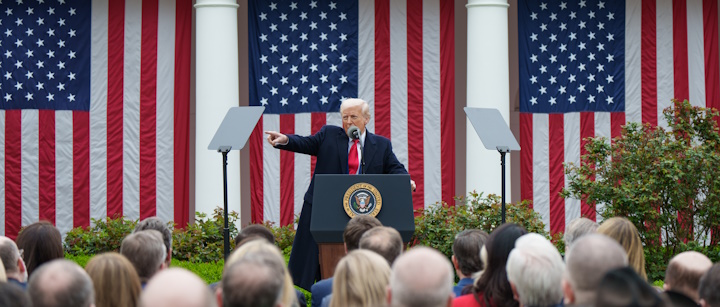Listen to the article
Tariff Revenue Surges to Record Highs, but Trump’s $88 Billion Claim Misses the Mark
Treasury Department data reveals that U.S. tariff revenue reached unprecedented monthly highs in April and May, though President Donald Trump’s recent claims about the figures contain significant inaccuracies. Trump has repeatedly stated that the U.S. “brought in $88 billion” from tariffs in “two months,” a figure that substantially overstates actual collections.
According to official Treasury Department figures, tariff revenue—formally known as customs duties—totaled $22.2 billion in May, setting a new monthly record. This represented a 42% increase from April’s $15.6 billion, which had itself marked a 90% jump from March’s $8.2 billion. While these numbers demonstrate remarkable growth, they fall far short of Trump’s $88 billion two-month claim.
The White House has not responded to requests for the source of the president’s figures. Analysis suggests Trump may be referencing the total tariff collections from October 2024 through May 2025, which amounted to $81.4 billion. However, this eight-month period included approximately three and a half months under the Biden administration before Trump took office in January.
The surge in tariff revenue coincides with Trump’s implementation of significant trade policy changes. In April, his administration enacted a minimum 10% tariff on U.S. imports of foreign goods, following March’s 25% tariff on certain goods from Canada and Mexico. The administration also increased tariffs on Chinese imports—initially from 10% to 20%, then to 145% in April, before reducing them to 30% in May. Additional 25% tariffs were placed on imported steel, aluminum, automobiles, and auto parts.
More than $28 billion of the fiscal year 2025 tariff revenue was collected during October through January, a period in which Trump was president for less than two weeks. The most revenue the U.S. has ever raised from tariffs in a calendar year was $102.3 billion in 2022.
Trump has also claimed the tariff revenue came with “no inflation.” While the Consumer Price Index shows inflation at 2.4% for the 12 months ending in May—only slightly higher than April’s 2.3% and lower than the 3% rate when Trump took office—economists warn this could be temporary.
Federal Reserve Chairman Jerome Powell cited “uncertainty” over “tariff inflation” when explaining the Fed’s recent decision to hold interest rates steady. “Everyone that I know is forecasting a meaningful increase in inflation in coming months from tariffs because someone has to pay for the tariffs,” Powell stated during a June 18 press conference.
Economic experts suggest several temporary factors may be delaying the inflationary impact. Stephen Stanley, chief economist at Santander U.S. Capital Markets, told the New York Times that “price increases are coming” and consumers “have lucked out a bit, in that retailers have shown restraint” so far. The Times reported that retailers’ built-up inventories have created a buffer allowing them to offer discounts and hold off price increases until stockpiles are depleted.
Jared Bernstein, former chair of the Council of Economic Advisers under Biden, predicts inflation increases could materialize in three to six months once these temporary factors dissipate.
The tariff situation has heightened tensions between Trump and Powell. Following the Fed’s decision to maintain current interest rates, Trump criticized Powell, suggesting he “maybe was a Democrat.” Powell, who served in the Treasury Department under Republican President George H.W. Bush and was initially appointed Fed chairman by Trump in 2018, is widely described as a “lifelong Republican.”
As the administration continues its aggressive trade policies, economists and policymakers remain watchful of potential inflationary pressures that could emerge in the coming months, potentially offsetting some of the perceived benefits of increased tariff revenue.
Verify This Yourself
Use these professional tools to fact-check and investigate claims independently
Reverse Image Search
Check if this image has been used elsewhere or in different contexts
Ask Our AI About This Claim
Get instant answers with web-powered AI analysis
Related Fact-Checks
See what other fact-checkers have said about similar claims
Want More Verification Tools?
Access our full suite of professional disinformation monitoring and investigation tools




5 Comments
Interesting analysis on the tariffs. Curious to see if the White House provides a source for Trump’s $88 billion claim. Seems like the actual Treasury numbers, while sizable, don’t quite match up with that figure.
I agree, the discrepancy between the reported numbers and Trump’s claim is notable. It will be worth watching for an official response from the White House on this.
The surge in tariff revenue is noteworthy, but Trump’s specific $88 billion figure does seem exaggerated based on the Treasury data cited. Curious to see if he was referencing a different time period as the article suggests.
Yes, the article’s analysis on the potential source of Trump’s $88 billion claim is helpful context. It will be interesting to see if the White House can clarify where that number came from.
This is an important fact check on Trump’s statements around tariff revenue. The Treasury data shows significant growth, but the president’s $88 billion claim appears to be an overstatement. Looking forward to seeing if the White House addresses this discrepancy.